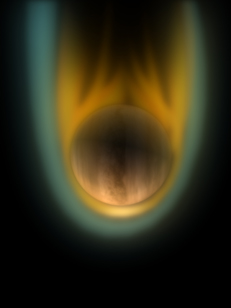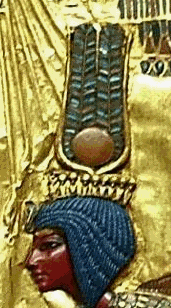

Venus, Athena Cometha, Quetzalcoatl, the plumed serpent, Lucifer.
"As Zeus's [Jupiter's] daughter [Venus] she'll be immortal and live in heaven with her brothers, Pollux and Castor, the heavenly twins, an extra star for ships to steer their courses by." -- Euripides, playwright, Orestes, 408 B.C.
"Democritus however, insists upon the truth of his view and affirms that certain stars [Venus] have been seen when comets dissolve." -- Aristotle, philosopher, Meteorology, 350 B.C.
"Some of the Italians called Pythagoreans say that the comet is one of the planets [Venus]." -- Aristotle, philosopher, Meteorology, 350 B.C.
"For the past 50 years or so, scientists have been talking about dust condensing at low pressures and gradually becoming pebbles, then boulders, etc. and building planets. While that process goes on to some extent, it would lead to oxidized planets without massive cores. I think in the main the planets rained out of the centers of giant gaseous protoplanets, which would account for their massive cores and, in the case of Earth, for her two component surface." -- J. Marvin Herndon, geophysicist, Email to the Noob, October 2008
Gary Gilligan: Velikovsky's Comet Venus.
Immanuel Velikovsky concluded from his extensive interdisciplinary research that the planet Venus was remembered from the time of the dawn of civilization as a brilliant cometary body.
While there is a wealth of literary sources to draw upon, when it comes to the pictorial evidence it isn’t as forthcoming. No images can be conclusively identified as actually representing Venus in cometary form, a situation that essentially shouldn’t exist. After all, it stands to reason that it was naked eye observations that primarily inspired the myths. So, at the very least the imagery should be equal to or analogous to the literary sources – but this clearly isn’t the case.
Have we overlooked something? Is it possible images of Comet Venus have been staring us in the face for decades?
The image on the right has been taken from the back of Tutankhamun’s throne. It depicts the wife of king Tut, Ankhsunamun. The queen is shown wearing a very distinctive crown consisting of a disk surmounted by cow horns and two tall plumes.
This unusual headdress made its appearance in the New Kingdom and features prominently in Egyptian art - numerous queens can be seen sporting this particular crown. Although the actual shape or outline remained constant (for approximately 900 years), there exist a few variants to the colours shown. For example, the disk was predominantly painted the traditional Egyptian deep red, the ‘horns’ normally black, while the plumes can be gold, a plain yellow, or blue and without the ‘filaments‘.
Like most Egyptian crowns encompassing a sphere, it somehow represents an aspect of the sun, or so the conventional way of thinking goes. This is a perplexing line of thought since the Sun is a golden glaring ball—it doesn’t have cow horns wrapped around it and most certainly exhibits no signs of enormous cometary tails.
It is apparent even to the uninitiated that what we are looking at here is a comet—a large comet with a plumed tail. Furthermore, if Egyptian art is used as a measure of time, this comet graced our skies for nearly a thousand years. It is carved, painted, and represented in statues the length and breadth the of Nile valley. Even the legendary Cleopatra wore this headdress.
Could this particular crown be a true-life physical representation of proto-Venus as it appeared in ancient times?
To quote Wal Thornhill:
'In the electrical model of the solar system, any body on a sufficiently eccentric orbit about the Sun will exhibit cometary features. For ancient people to have seen Venus as an Earth-threatening comet, Venus must have had an eccentric orbit that brought the planet near to Earth'.
Are we looking at Velikovsky’s comet Venus?
Comparing the comet crown with the Venus diagram on the left reveals some fundamental similarities, far too close to be deemed coincidental. In fact, for all intents and purposes they are virtually identical!
The orb represents the body of Venus: the horns signify the bow shock as the solar wind slams into the Venusian surface, enveloping its body due to a lack of an intrinsic magnetic field. The two large plumes represent Venus’ magnetotail—split in two and flowing downstream at least three times its diameter.
The image on the left is just a diagram, and today Venus’ comet tail can only be detected by magnetometers and charged particle detectors. However, place Venus on an eccentric orbit in a highly charged ‘dusty’ environment and the normally invisible magnetotail (and bow shock) would become highly visible.
Wal Thornhill commenting on Venus’ cometary magnetotail:
'A power surge in those filaments today would cause them to glow, and Venus would form a "stupendous" cometary apparition in the sky. The forensic evidence would stand up in court, showing that Venus was a comet within human memory'.
Science is slowly proving Velikovsky to be correct in a number of areas. Perhaps with the comet crown of ancient Egypt we now have the pictorial evidence to match.














8 comments:
sometimes conclusions are just plain wrong
Is this the only interpretation of the headress symobolism? Could it be a giant Yoni (vaginal canal to the uterus where you can deposit a seed and grow stuff)?
Only the morbidly ignorants take others views and cut and paste away...
Look at the pic under the post on Milton: it looks like a giant dick! Man, you really would need a bigass yoni to satisfy it. OIM, good you found all these enlightening pics.
QF,
Historical observations are observations not conclusions.
"He [Tiamat] marked the positions of the wandering stars to shine in their courses, that they may not do injury, and may not trouble any one." -- Enuma Elish, Fifth Tablet of Creation
"For if the Olympian who handles the lightning [Jupiter] should be minded
to hurl us [planets] out of our places, he is far too strong for any."
-- Homer, poet, Iliad, I:580-581
"Nay, truly, I might carry this matter still higher, and if one planet must be made parent another, justly claim the principal place for Jupiter, probably above 200 times as big as our Earth, and the largest and most considerable of all the Sun's chorus...." -- William Whiston, mathematician, 1737
OIM,
What you have cited are not observations, they are incantations of ignorants and powerfreaks.
A comet does not just pop up to say hello. It takes years and months to traverse distances. We have enough knowledge to calculate how close an object like Venus has to come to the Earth to create all the havoc attributed to it. And, by the same token, it is back calculable when such a comment entered the system for given historical dates for a headress to be intimated.
Otherwise, it is all mindfuck, beamfuck, or selffuck.
I actually like the model of a yoni of a flower as the motivation for a headress. Egyptians also like to get high smelling blue lotuses, look it up.
OIM, historical "observations" are no more accurate that future "predictions".
Far more accurate imo.
I love the interpretation. Thank you for posting this.
Post a Comment